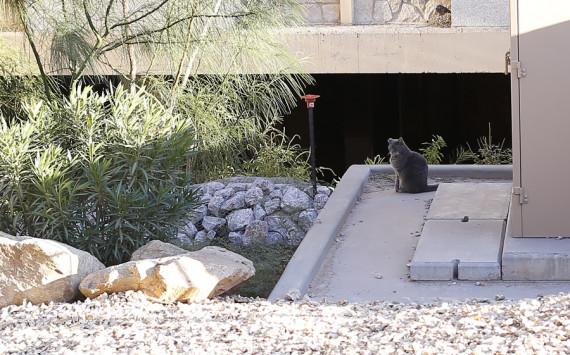
Aaron Montes
aaron montes / The Prospector Feral cats are unadoptable and when they are taken to animal shelters, 99 percent of them will be euthanized within three days..
As UTEP continues to transform, one thing has stayed constant in the untouched shadows—the feral cat population on campus.
Since its inception in 2000, the Trap-Neuter-Return program on campus has operated on-and-off throughout the years.
Since December 2012, the TNR program, operated by the Environmental Health and Safety department, has started up again due to a slight increase in the cat population.
A new micro-chipping initiative began this year along with regular procedures, where volunteers set traps to capture the cats, spay or neuter them, vaccinate them for rabies and return them back to campus.
“We started seeing kittens again from other places we don’t know,” said Robert Moss, assistant vice president for EH&S. “We have trapped 46 cats in total since. Forty were spayed or neutered and returned to campus, five were adopted and one was put down because he was very sick.”
The goal of the TNR program is to provide a humane solution to the cat population rather than using the catch-kill technique, where cats were trapped and immediately taken to animal services to be euthanized—a technique used in previous years in El Paso communities.
“We do the humane thing,” Moss said. “We have recently associated with El Paso Animal Services because they were willing to expand their program to us.”
Moss said El Paso Animal Services is called as a last resort if the TNR team cannot care for the cats.
“They’re desperate animals that are left alone and because they’re alone, they get hurt,” Moss said. “Especially now with construction, they are spooked.”
Moss and the rest of his staff create spreadsheets of the cats that have already been captured and spayed or neutered. Pictures are taken of each cat and a note is made on where that cat was found. Once the procedure is completed, they are released in the same area.
Anahi Marquez, senior cellular and molecular biochemistry major, is not a fan of cats, but she said she isn’t bothered by the ones that cross her path on campus.
“I feel bad for any people that are allergic to them and for the cats themselves, but it would be nice if they found a home to be taken care of,” Marquez said. “I feel that the construction could potentially harm them. I mean we are all a little disturbed by the construction and any shelter they had could have been destroyed or they could get hurt by the machinery.”
Along with the TNR program at UTEP, there are several other organizations around the city that utilize this technique in order to reduce the number of free-roaming, or feral cats, in the El Paso community.
Sun City Cats was created last year and has been endorsed by the El Paso Veterinarian Association, The Animal Shelter Advisory Committee and Animal Services. The SCC follows strict guidelines in order to deliver humane solutions.
Feral cats are unadoptable and when they are taken to animal shelters, 99 percent of them will be euthanized within three days. The procedure for euthanizing an animal comes directly from tax-payer dollars.
Kurt Fenstermacher, deputy director for the El Paso Environmental Services Department, is in partnership with Sun City Cats and is currently applying for a second grant under PetSmart Charities.
“They offered us the opportunity to go to the 79907 zip code to help 1,000 cats. So the groups went out there and the cats were spayed and neutered and micro-chipped, which is different for El Paso,” Fenstermacher said. “The grant with PetSmart Charities is renewable, so they will give us another area code to help another 1,000 cats along with some money.”
The first grant was received in October 2012 with $50,000 going toward the spay and neuter program.
“That’s a lot more than we have ever spent on a spay and neuter program. A non-profit organization is granting us this money, and in turn, we do the surgeries, the volunteers take the cats back, and they don’t get picked up by the officers,” Fenstermacher said. “Hopefully, we’ll see a reduction in the cat-related nuisance calls and the number of free-roaming cats with the TNR program.”
It may take three to five years for the effects to become visible, but until then, SCC and other animal services will continue to go to specific areas with a high number of impounds reported and continue the TNR techniques there.
Because people are being irresponsible by dropping off cats and leaving them on campus, whether it’s students or people from the city, it keeps the problem from getting better, Moss said.
“We have other problems with feral animals when food is left out. There are people that aren’t being responsible for their animals. I wish they would, but animals are still roaming the campus,” Moss said. “We don’t encourage people to leave animals here. It’s a rough life to be a free-range animal within a city.”
Students interested in helping or volunterring for the feral cat program or the spray/neuter program can visit suncitycats.org.
Lorain Watters may be reached at theprospectordaily.news@gmail.com.